Flood History
Stream Gage for Santa Ana River
Flood History
History of floods in San Bernardino County.
1769 to 1899
Flood history in the Santa Ana River Basin is traceable since the days of the entry of the Spanish Mission Fathers into the Los Angeles and San Bernardino areas between 17969 and 1776. Based upon a wide variety of diaries, special reports, court records and writings of residents, the period from 1769 and 1859 experienced what would be referred to as eight ” small” floods, seven “large ones, and one “great” flood.
The “great” flood occurred in the 1824-25 season which was described as “probably the greatest of earlier recorded floods”. The flood of 1825 is known to have altered the course of the Santan Ana River, causing it to enter the Pacific Ocean several miles from prior entry point.
of particular interest are the “great” floods, in 1862, 1867 and 1891. in the San Bernardino Valley flood of 1884 approaches this category.
Flood of 1891
Of all the floods, 1862 is by far the greatest record and has been referred to as the Noachian deluge of California floods, during which the Santa Ana River is said to have rivaled the “Father of Waters”. Rainfall started on Christmas Day 1862, and continued until the 18th day of January 1862, when commenced a 24-hour downpour. It has been stated that the area from Loma Linda to the hill at Third Street and Arrowhead Avenue in San Bernardino was under the water and extended for miles up and down the Santa Ana River. At Agua Mansa below Colton, it is recorded: ” There were billows 50 feet high. The waters from the vast drainage area found themselves forced abruptly into a narrow channel, and just above Agua Mansa the river filled the valley from bluff to bluff, reaching the little church. Father Borgatta, then the pastor, heard the roar in the distance, rang the bell frantically and the people fled to high ground. Some of the last ones had to swim.”
“In quick succession, six years later, came the “great” flood of 1867 which is reported to have approached the 1862 event in magnitude, but it was written that: “Since the first flood had cleaned the channels, the damage done by the second storm appeared to be less.”
The season of 1883-84 is known as the wettest year of record with San Bernardino reporting 36.5 inches of rainfall. The flood produced on March 6, 1884, though somewhat less than the 1938 event, ranks with the major floods and is referred to as “the great Flood of Later Times”. great damage was inflicted to newly installed railroads and once again the course of the Santa Ana River was altered.
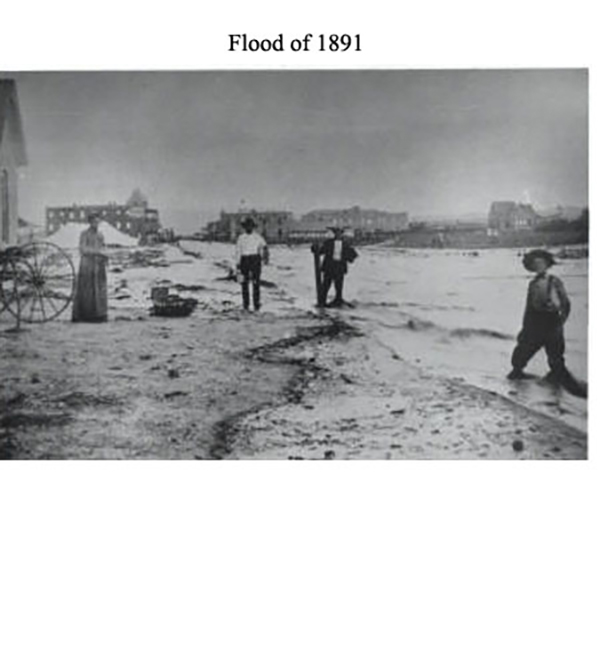
1900 to 1949
Large, though lesser, floods occurred in 1920 and in 1916. Typical reports on these read: “East section of city (San Bernardino) under water and in west end houses float.” “Millions of storm damage in the southland – The entire Mexican section of East Highlands was swept away by Plunge Creek, 20 families – The Santa Ana River is now two miles wide and twenty feet deep – Disastrous flood sweeps across west end.”
On March 2-3, 1938, the County was again swept by a “great” flood and the most damaging to that date due to the state of physical property improvements. There were 14 known deaths in the County with damages estimated at $12 million. Practically no part of the San Bernardino Valley or Mojave River Valley escaped the wrath of this storm. Almost every community was isolated with roads and bridges destroyed. Hundreds were homeless. During the 31 years between 1938 and 1969 there were no “general” floods of note in the Santa Ana River Basin except for a moderate one occurring in 1943 with damage primarily to Lytle Creek and the Mojave River Valley.
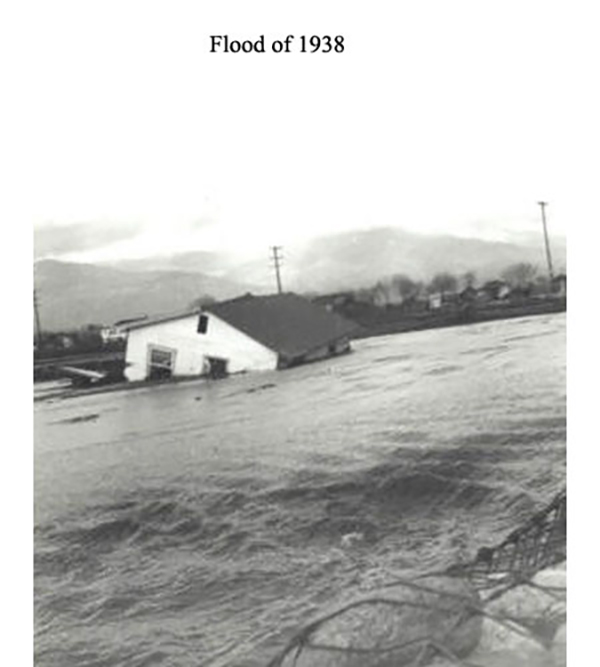
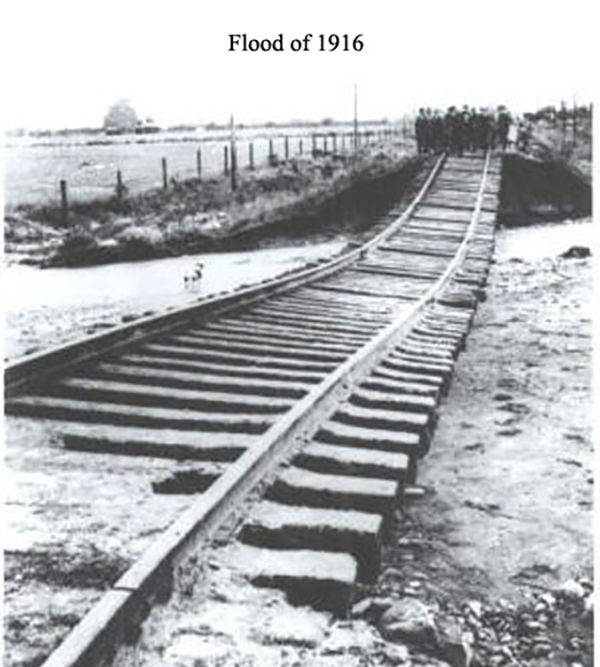
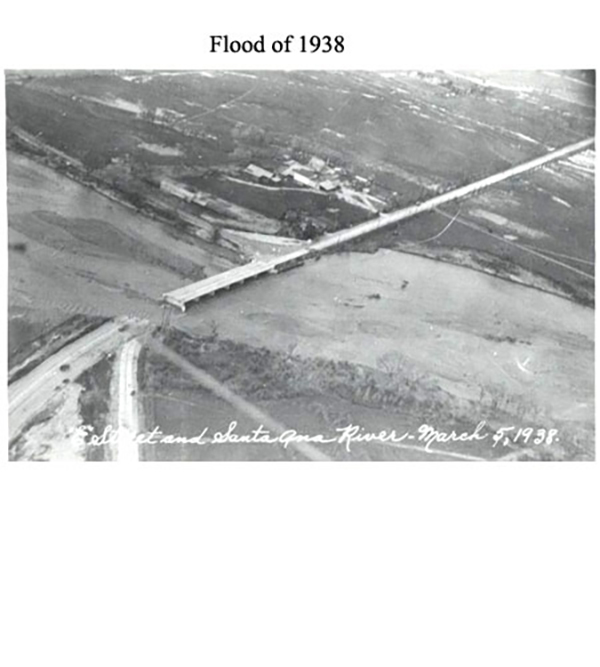
1950 to 1969
Moderate “general” floods also occurred in 1952, 1956, 1965 and 1966. Eclipsing, in many respects, the flood of 1938 were the “great” floods of January and February 1969, occurring a month apart. Rainfall intensities and amounts were greater, and, except for the Mojave River and its tributaries, runoff peaks were generally greater during the two 1969 floods. Although Flood control Facilities functioned splendidly during the January flood period, there was insufficient time to perform necessary repairs and maintenance before the late February storm struck which caused nearly twice as much damage. Pecuniary losses in San Bernardino County alone from the January storm amounted to over $23 million and from the February storm over $31 million. This is, however, only a portion of the losses which would have been sustained had no flood control protection been provided. The severe flooding throughout Southern California inflicted costly damages exceeding $213 million in tangible property losses and exacted 115 human lives. San Bernardino and six neighboring counties were declared national disaster areas.
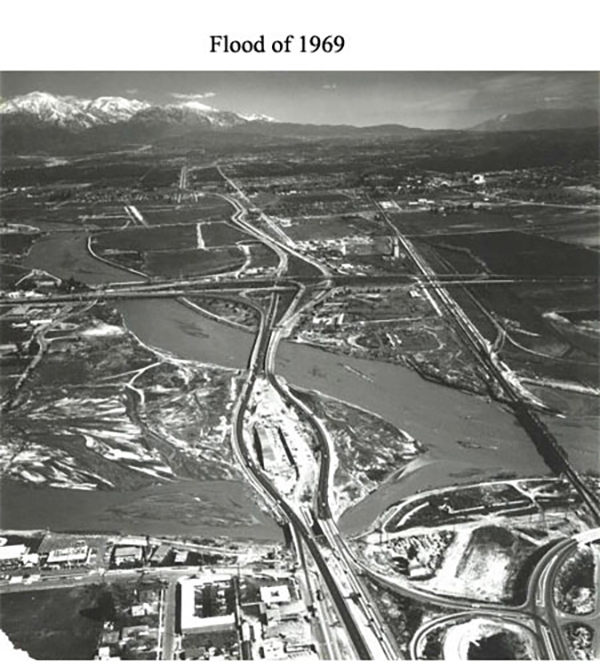
1970 to 1979
Since 1969 the flood history of San Bernardino County has remained relatively stable with just one occurrence in 1978 of a “general” storm which approached the magnitude of the 1943 and 1965 storms. The existing flood control facilities functioned well in 1978, but did sustain substantial damage from erosion and debris deposition. Total property damage from the 1978 storm is listed at $11.4 million dollars.
There were no breakouts of flood flows; however, the earth levees of Cucamonga Channel downstream of Foothill Boulevard were critically eroded and evacuation of a portion of the City of Rancho Cucamonga was initiated. Construction of the Cucamonga Creek Corps of Engineers Channel was completed to Foothill Boulevard the following year, and the entire project, including tributaries Deer Creek, Demens Creek and San Antonio Heights intercept which will provide major flood protection for West Ed cities, is scheduled for completion in 1983.
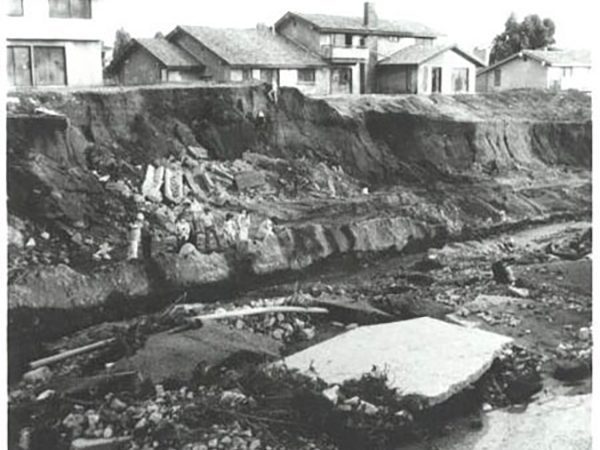
In addition to the 1978 “general” storm, the County has been hit with numerous localized high intensity storms, particularly 1976 in the East Desert (Morongo, Yucca, and Twentynine Palms) and the City of Redlands. In September a thunderstorm above the Crafton Hills dropped rainfall approaching four inches, with 75 to 100% occurring within a 30-minute time span. In Redlands, water flows of up to three feet deep caused flooding of the downtown business area and more than 200 homes. There was an estimated $1,750,000 worth of damage; $1 million to the public and private and $750,000 to flood Control Facilities County wide.
1980 to 1989
More recently the San Bernardino mountains were subjected to concentrated high-intensity rainfall in January and February of 1980. District gauges recorded shot duration rainfall in excess of one inch per hour which fell on the denuded watershed burned by the Daley and Shadow fires of September 1979. Many debris basins above the City of San Bernardino were filled with mud and debris, particularly Harrison Basin which overflowed into the neighborhood below on four occasions totally destroying 25 to 30 homes neighborhood and severely damaging 25 more. the February storm, which approached an overall “general” storm, caused small Canyon Basin to overflow pouring mud, water and debris into houses along Small Canyon Outlet channel and the residential areas below Highland Avenue and Mountain shadows. Between January and March more than 30 inches of rain fell, causing $18 million damage in San Bernardino County, $8 million of this occurring to Flood Control District facilities.
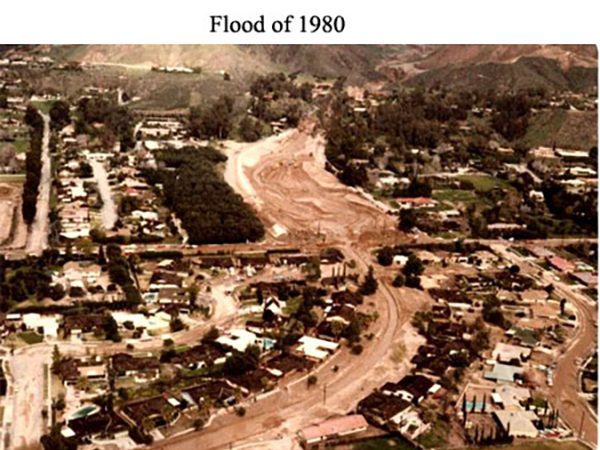
Fall of 1980 brought with it heavy Santa Ana winds and again devastating watershed burns. The Panorama Fire destroyed or damaged 333 homes and 23,800 acres; combined with the Baldy and other fires, more than 41,000 acres of mountain watershed was burned. Fortunately, 1981 and 1982 were mild water years. That, combined with an extensive $5 million federally financed District basin over-excavation program, has allowed the San Bernardino Valley to survive Nature’s latest wrath with minimal damage.
1990 to 1999
More recently the San Bernardino mountains were subjected to concentrated high-intensity rainfall in January and February of 1980. District gauges recorded shot duration rainfall in excess of one inch per hour which fell on the denuded watershed burned by the Daley and Shadow fires of September 1979. Many debris basins above the City of San Bernardino were filled with mud and debris, particularly Harrison Basin which overflowed into the neighborhood below on four occasions totally destroying 25 to 30 homes neighborhood and severely damaging 25 more. the February storm, which approached an overall “general” storm, caused small Canyon Basin to overflow pouring mud, water and debris into houses along Small Canyon Outlet channel and the residential areas below Highland Avenue and Mountain shadows. Between January and March more than 30 inches of rain fell, causing $18 million damage in San Bernardino County, $8 million of this occurring to Flood Control District facilities.
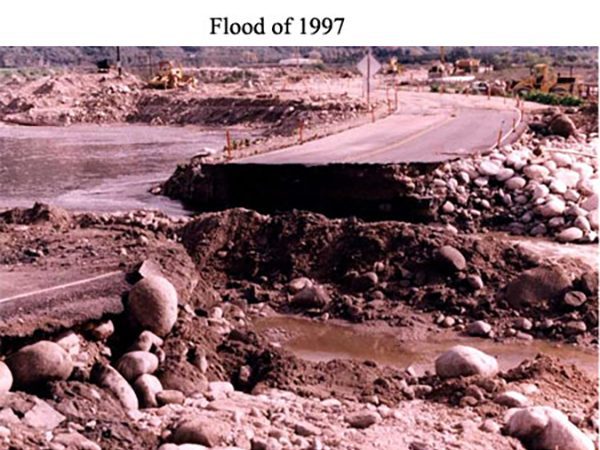
February 1998 was the most productive rainfall month during the 1997/98 winter. 14.59 inches of rain was recorded for the month at the Gilbert Street Guage in San Bernardino. the major storm event that occurred in the Valley was on February 23rd. the rain gauge at Gilbert Street recorded 3-10 inches for the day. prior to the 23rd, a series of storms starting on February 14th occurred almost back-to-back. The Storms brought light to moderate rainfall except for for February 22, which recorded 2.18 inches of rain. The existing antecedent moisture conditions contributed greatly to the impact of the storm of the 23rd.
2000-
A Pacific Storm system moved through Southern California on December 25th and 26th, 2003. Heavy rain fell over much of the mountains and foothills causing flash flooding and debris to wash across several highways and roads. In a few locations, including Lytle Creek, rainfall rates of up to an inch per hour were recorded. Just south of Crestline, rainfall rates increased from 0.20 to 0.70 inches within a five-and-a-half-hour span, causing mud, water and rockslides. The debris flowed down into Waterman Canyon moving through Saint Sofia Camp killing 14 people. Continuing down Waterman Canyon the flow took out the two bridges and finally fanned out filling the basins just north of San Bernardino. A flash flood/mud slide moved through Cable Canyon and the KOA Campground, killing 2 people, a bear, and a horse and destroying 32 travel trailers, multiple vehicles, and roads. In all, 33 of the 34 debris basins along the foothills in the San Bernardino Mountains were filled with rocks, trees, and mud.
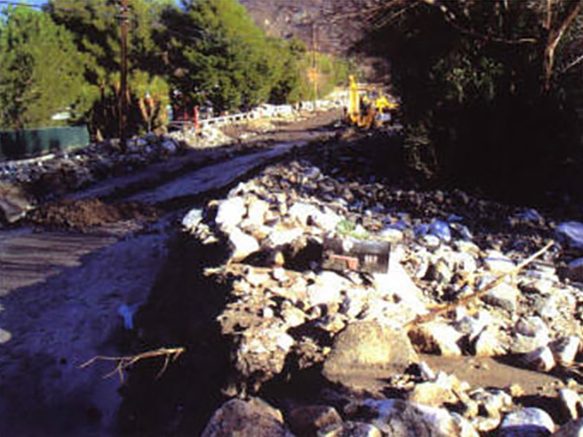
The first major storm of 2004 occurred October 19-20. The storm was expected to have significant rainfall intensities and large runoff due to recent watershed burns. Fortunately, the flows from the burn areas ended up being relatively “clean” thus allowing the Regional Flood Control System to handle the storm runoff developed by this storm. Any flooding experienced within the cities or developed areas was a result of debris blocking inlets and overtaxed local drainage systems. The only noteworthy damage was the washout of the small wood railroad bridge crossing the undeveloped portion of the San Sevaine Channel, southerly of Whittram. There was also a derailment of a chlorine car and boxcar and exposed utility lines, 16″ jet fuel line and 20″ gas line, caused by the storm flows collapsing the north set of tracks.